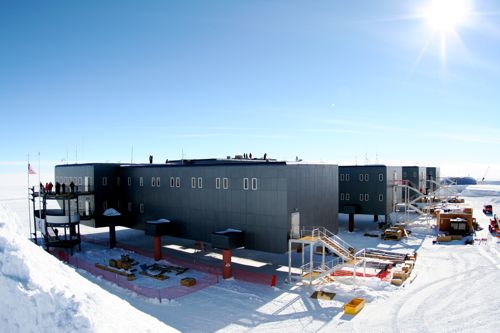Almost all the material that gets to the south pole is transported using LC-130 Hercules planes ("Hercs"). Every day, Hercs come in, drop off equipment, people, and fuel, and then take off again for McMurdo, carrying people and any waste stuff that needs to be hauled out.
But it turns out, there are a couple of other ways that the South Pole can receive supplies. And I was lucky enough to see both of these occur in the same week!
The most obvious way to get stuff to the Pole would be to transport it by land somehow. Every once in a while, a convoy of vehicles arrives overland from McMurdo station, hauling large sleds of fuel and equipment and food. It takes about a month for the convoy to reach the Pole, but they can haul a tremendous amount of stuff so it is reasonably fuel efficient compared to flying it in on Hercs.
 This convoy of vehicles started out from McMurdo Station almost a month ago, bringing supplies and fuel. Quite an event when we receive an air drop AND a traverse on the same day!
This convoy of vehicles started out from McMurdo Station almost a month ago, bringing supplies and fuel. Quite an event when we receive an air drop AND a traverse on the same day!
A more exciting way would be to fly over and drop it using parachutes. About once a year, a C-17 (much larger than a C-130) takes off from McMurdo carrying huge pallets of food and supplies, and flying a few hundred feet above the Antarctic plateau, opens its enormous back door (these planes commonly carry things like tanks and helicopters inside them), and the crew shoves the stuff out the back with parachutes attached. Traditionally, the C-17 then does a couple of very low passes along the skiway, waggling its wings in salute to the South Pole crew. It is quite a sight to see such an enormous powerful plane roaring across the ice - the pictures don't do it justice!
 The back hatch of the C-17 opens up wide to allow the crew to release parachuted crates.
The back hatch of the C-17 opens up wide to allow the crew to release parachuted crates.
 The C-17 made two passes to drop cargo, dropping six crates in each pass.
The C-17 made two passes to drop cargo, dropping six crates in each pass.
It turns out that really, the air drop is not done out of necessity, but for practice for the flight crew. During the winter time, planes simply not able to land at the pole, so in a winter emergency, the only way to bring supplies (such as emergency food or medicine) is by an air drop. Even this is a very dangerous undertaking so it is rare and taken very seriously.
 The crates touch down not-so-gently into the Antarctic snow.
The crates touch down not-so-gently into the Antarctic snow.
 A team of South Pole cargo staff and Air Force personnel released the crates from their parachutes and transported the cargo back to the station. I love the clouds in this photo.
A team of South Pole cargo staff and Air Force personnel released the crates from their parachutes and transported the cargo back to the station. I love the clouds in this photo.
But in the summer time, it is a cause for curiosity and celebration as everyone turns out to witness the air drop. The up-close photos of the air drop are courtesy of Forest Banks, a ten-year veteran of the Pole who also happens to be an excellent photographer - he was right under the plane along with the cargo crew who retrieved the airdropped supplies.
 Air drops are a rare event, once a year if that. So the entire base gets excited to come out and watch the spectacle, finding vantage points near the drop site, or from high points on the station itself.
Air drops are a rare event, once a year if that. So the entire base gets excited to come out and watch the spectacle, finding vantage points near the drop site, or from high points on the station itself.
 This intrepid spectator climbed up on top of the old Dome station to watch the air drop.
This intrepid spectator climbed up on top of the old Dome station to watch the air drop.
